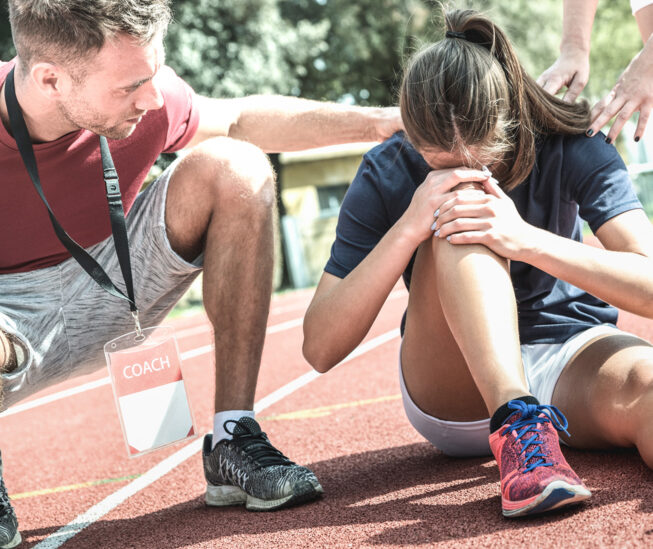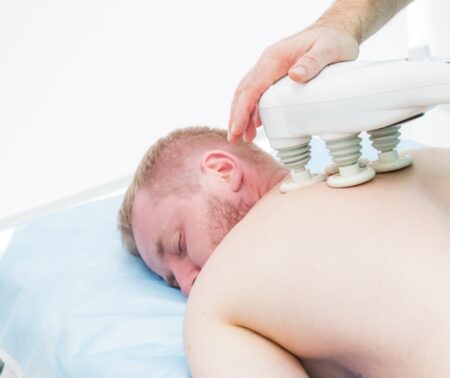Comprising more than half of all athletic injuries, knee injuries are very common. Unfortunately, they are also debilitating, preventing you from playing the sport you love and living the active life you deserve. Addressing these injuries, and their cause, with prompt, professional treatment, however, can help you get back to crushing your sport again. Here is a look at 5 of the most common knee injuries, and some of the most effective ways to treat them.
Anterior Cruciate Ligament (ACL) Tear

The anterior cruciate ligament (ACL) is one of four strong bands of tissue called ligaments that provide stability to your knee. The ACL sits inside your knee joint and crosses in front of the posterior cruciate ligament (PCL).
Most ACL sports injuries occur when the knee receives a powerful hit while the foot is set on the ground. Often, a tackle or a hit in football or soccer provides enough force to harm the ACL, although landing after a jump or rapidly changing direction can also cause this type of injury.
Symptoms of an ACL tear include any of the following:
- Pain outside the knee
- Pain at the back of the knee
- Loss of motion
- Pain while walking
- Swelling
- A feeling of instability in the knee
- The sound of a “pop” when the injury occurs
ACL Tear Treatment:
Some minor injuries can heal with rest, rehab, and stabilization. However, most ACL tears will require surgery to repair, since a lack of blood flow to the ligament makes natural healing almost impossible. After surgery, you can expect to engage in a sports medicine rehab program focused on strengthening the muscles around the knee (e.g. the quads), balance and stability work, and eventually, a return to your preferred sport.
Meniscus Tear

The meniscus is a c-shaped piece of cartilage that sits between the thigh and the shin bone, providing support and cushioning where these bones come together. You have two of these cartilages – Inside and outside your knee.
Both are susceptible to injury during abrupt movements. Most often, sudden twisting or falling creates enough force to tear these important shock absorbers in the body. You may also injure the meniscus in a similar manner to ACL tears – Sharp, sudden force applied to a taut leg, such as during a football tackle. Meniscus tears can vary in severity and are often listed according to grade, from 1 to 3, with 3 being the most severe.
Symptoms of a meniscus tear include any of the following:
- A “pop” at the time of injury
- Swelling and/or stiffness in the knee
- Difficulty straightening the knee
- Tenderness and knee pain
- Instability
- Locked knee
Meniscus Tear Treatment:
Depending upon the severity of the injury, there are three potential treatments that you may undergo. The first is simply rest, including the RICE method of Rest, Ice, Compression, and Elevation).
The second approach is surgery. Most often used for meniscus tears that are accompanied by other injuries, it usually involves an arthroscopic technique. This approach inserts a camera, and appropriate surgical tools, into the knee in order to visualize the damage and repair it.
The third approach is chiropractic care. You will likely utilize chiropractic care either in place of surgery or as a way to recover afterward. You will focus on strengthening the muscles around your knee and regaining stability so you can get back to playing your sport.
Patellar Tendonitis

Also known as jumper’s knee, patellar tendonitis consists of the inflammation of the tendon that runs between the kneecap and the shin bone. Most often caused by overuse, this injury consists of multiple small tears in the tendon that then become painfully inflamed.
Symptoms of this condition can include any of the following:
- Swelling
- Pain when jumping, walking, or otherwise using the knee
- Tenderness behind the kneecap
Patellar Tendonitis Treatment:
You will not usually require surgery to repair this type of sports injury. However, you will need to engage in the RICE method and refrain from activities that could exacerbate the problem. In addition, you may undergo chiropractic care to stretch and strengthen the knee.
Iliotibial (IT) Band Syndrome
The IT band is a tendon that runs from the pelvis down to the knee. When this band becomes tight for too long, it can rub against the hip bone or the knee bone and become inflamed.
Known as iliotibial band syndrome, this problem most often occurs among athletes who engage in repetitive leg movements that overuse the tendon. Athletes most prone to this condition include runners, cyclists, and others who consistently bend their knees during their sport.
Symptoms of IT band syndrome can include any of the following:
- Pain in the hip
- Clicking on the outside of the knee
- Knee pain
- Redness or warmth outside the knee
IT Band Syndrome Treatment:
There are many potential treatments for iliotibial band syndrome, including rest, steroid injections, and pain medication. Chiropractic care can also help. In this approach, manual therapy is often utilized to relax and stretch the tendon. In addition, your provider may give you certain exercises meant to lengthen the tendon. They will also provide you with education and exercises to help you avoid the same problem in the future.
Knee Bursitis
The bursa is a small, fluid-filled sac near your knee joint that serves as a cushion within your knee. When this sac becomes inflamed, the condition is referred to as knee bursitis.
Knee bursitis often occurs among athletes who suffer frequent falls or force applied to their knee. Sports that often lead to this condition include running, football, wrestling, and volleyball.
Symptoms of this condition can include any of the following:
- Tenderness in the knee
- Swelling in the knee
- Pain even when not using the knee
Knee Bursitis Treatment
Surgery for knee bursitis is rare, often only occurring if an individual experiences repeated bouts of the condition. More commonly, medication, compression sleeves, braces, and steroid injections are utilized to help rest the area and reduce pain.
In addition, you may receive chiropractic care to help strengthen your knee. The goal of this therapy is both to ease your condition more quickly and equip you with the tools, strength, and flexibility you need to avoid a repeat of the bursitis.
If you are experiencing any kind of knee pain or injury, you should seek out professional assistance in order to get back to the sport you love more quickly. Dr. Roy Nissim is dedicated to helping you find the cause of your pain, and eliminate it, with a chiropractic treatment that gives you less time in treatment and more time playing your favorite sport. Contact us today to learn more and set up an appointment to help with your knee injury!





